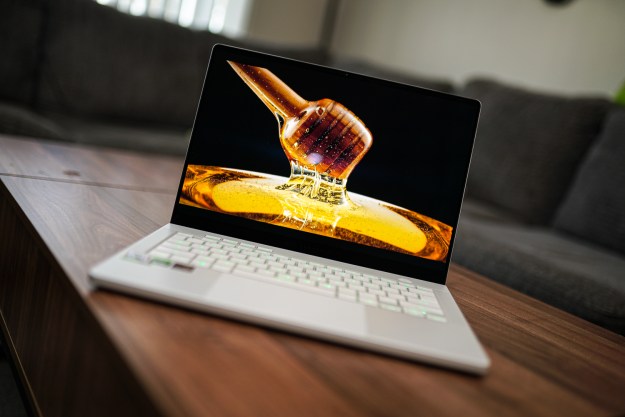
“The ROG Zephyrus G14 (2024) achieves a level of greatness no other gaming laptop has been able to pull off.”
- MacBook-like thinness and weight
- Gorgeous OLED display
- Redesigned charger and USB-C power delivery
- Great productivity performance
- Much cheaper than the competition
- A little behind in games
- Soldered memory
It’s safe to call the Asus ROG Zephyrus G14 a legendary laptop, as it has been among the best gaming laptops you can buy since its inception. Asus had a winning formula that combined a sleek frame, flagship hardware, and a price that’s attainable for gamers on the go. So, why would you throw it all away?
The 2024 Zephyrus G14 is a radical departure. Fewer hardware options, a new aluminum chassis, and an OLED screen serve as the bedrock for what feels like an entirely new laptop. This doesn’t feel like the Zephyrus G14, but that’s OK. A series of smart compromises add up to a laptop unlike any other that offers a balance of portability and power at a price the competition just can’t reach.
Asus ROG Zephyrus G14 (2024) specs

Compared to last year’s lineup, Asus simplified the options on the 2024 Zephyrus G14. Every configuration comes with a few baseline specs, including an AMD Ryzen 9 8945HS processor, 1TB of PCIe 4.0 storage, and a 3K OLED Nebula HDR display. All configurations I can find right now also come with 32GB of LPDDR5X-6400 memory, but there’s a little more to that story.
Unlike previous versions, the memory on the 2024 Zephyrus G14 is soldered. You can’t upgrade or replace it. Even laptops like the Razer Blade 14 allow you to replace the memory if you want.
| Asus ROG Zephyrus G14 (2024) | |
| Dimensions | 12.24 x 8.88 x 0.64 inches |
| Weight | 3.31 pounds |
| Processor | AMD Ryzen 9 8945HS |
| Graphics | Nvidia RTX 4070 (90W TGP) |
| RAM | 32GB LPDDR5X-6400 (soldered) |
| Display | 3K (2,880 x 1,800) OLED, 120Hz, G-Sync |
| Storage | 1TB PCIe 4.0 NVMe SSD |
| Touch | N/A |
| Ports | 2x USB 3.2 Gen 2 Type-A, 1x HDMI 2.1, 1x 3.5mm, 1x USB 3.2 Gen 2 Type-C, 1x USB 4 Type-C w/ 100W power delivery, 1x microSD card reader |
| Wireless | Bluetooth 5.3, Wi-Fi 6E |
| Webcam | 1080p w/ Windows Hello |
| Operating system | Windows 11 Pro |
| Battery | 73WHrs |
| Price | $2,000 |
| Where to buy |
Memory is a major point of contention on the Zephyrus G14. It’s hard to say if some retailers will have 16GB models available, but I’d strongly recommend going for 32GB if you can. The soldered memory likely helps Asus achieve a more portable form factor, but it also vastly limits the upgradability and repairability of the laptop.
Otherwise, the main difference between configurations is the GPU. Unlike last year’s model, which supported a range from an RTX 4050 up to an RTX 4090, the laptop now goes from an RTX 4050 to an RTX 4070. These GPUs don’t run at their maximum power, either. Asus caps all of them at 90 watts, with a base power of 65W and an additional 25W coming from Dynamic Boost.
That’s less power compared to previous designs, and if you know anything about Total Graphics Power (TGP) in laptops, it looks like a bad thing. Thankfully, Nvidia’s most recent GPUs are surprisingly efficient, and the G14 gives up very little performance with its slashing of the power budget (more on that later).
A radical redesign
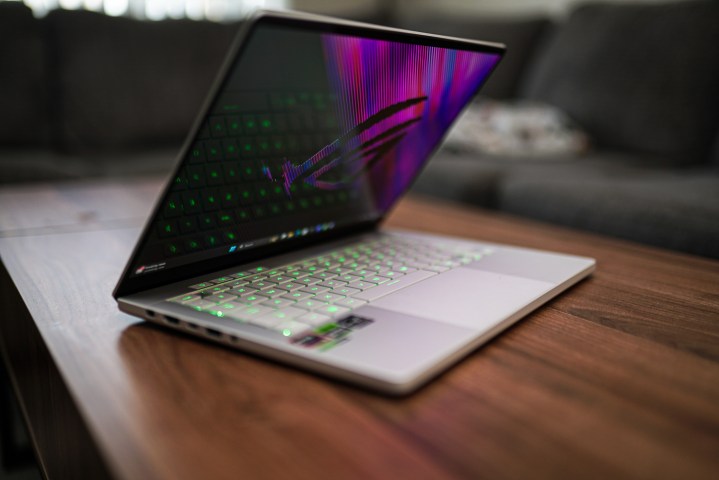
A lot has changed for the Zephyrus G14, most notably the aluminum body that Asus is now using. It’s a stark difference from previous designs that used a plastic shell, giving the Zephyrus G14 a premium fit and feel that help it sit alongside laptops like the Razer Blade 14 and Alienware x14 R2. You could make an argument that it even punches up to the MacBook Pro.
The sleek silver frame looks fantastic, and it allows the Zephyrus G14 to achieve some impossible dimensions. The laptop is just 0.63 inches thick, which is a fraction of an inch thicker than the Alienware x14 R2 — and a fraction of an inch thinner than the Razer Blade 14. The big deal here is the weight, though. I was shocked when taking the laptop out of the box at how light the 3.3-pound laptop felt.
Competition from Razer and Alienware may come around the same thickness, but they’re both over 4 pounds. This is MacBook Pro weight. In fact, the 14-inch MacBook Pro with an M3 Pro or M3 Max weighs more than the Zephyrus G14, even when Asus’ laptop is tricked out with an RTX 4070. It’s such an outrageous change that I pulled out the scale — and yeah, the laptop is 3.3 pounds.
There are definitely some concessions to reach this weight, though. The soldered memory is a major point of contention on the G14, and the laptop carries a relatively small 73 watt-hour battery. Thankfully, the battery is offset by lower power draw on the GPU, which I’ll dig into a little later.
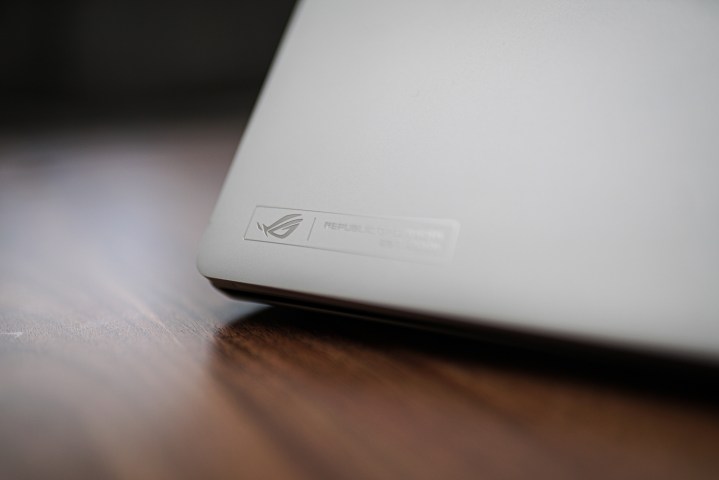
Visually, the 2024 Zephyrus G14 looks fantastic. It’s all silver, and the plastic ROG badge we saw on previous models is now stamped into the aluminum frame. You have options for silver or black, neither of which would look out of place at a coffee shop despite the gaming-focused hardware. It looks like a premium Windows laptop, not a gaming laptop.
The Zephyrus G14 loses something in its transition to a more mainstream look, though. The signature bump on previous designs, where lifting the lid allowed you to prop the laptop up at an angle, is gone. It’s a more conventional clamshell now. And the LED array that you can purchase with Asus’ AniMe matrix is gone, replaced by a diagonal line with a series of lights.
It calls back to the previous Zephyrus G14, but this is a different laptop entirely, and I wished Asus treated it as such. In particular, the Slash Lighting looks a bit off. You have little control over how it works, instead relying on a series of presets from Asus that provide slightly different versions of the lights fading or flashing in different zones. There are a few party tricks, like the Slash Lighting reacting to sound or lighting up for notifications, but I ended up keeping the light solid the majority of the time.
This is an evolved G14, and in the process of evolution, the laptop sheds some of its gamer skin. There are areas where that’s an asset, including the premium finish of the aluminum body and ultralight weight — and other areas where something’s been lost. The biggest loss here is definitely the body bump in previous versions, which helped not only typing, but also thermals.
Excellent connectivity remains

Asus may have moved the design of the G14 closer to that of a MacBook, but it didn’t give up any connectivity in the process. You still get a full-size HDMI 2.1 port, two USB 3.2 Gen 2 Type-A ports, and dual USB-C ports, one USB 3.2 Gen 2 and the other USB 4. That USB 4 port supports power delivery, too, up to 100W.
In addition, Asus crams in a microSD card reader and a 3.5mm headphone jack. The split here is great, too. Both types of USB ports are split with one on each side, and larger connections like the HDMI 2.1 and headphone jack are on the left side of the laptop, keeping them out of your way if you’re using a mouse.
Asus went further with the power connection, too. One my biggest issues with the previous design was the barrel power adapter, which was at a 90-degree angle and centered on the left side of the laptop. Asus replaced the power plug with a straight, square adapter that feels much more secure, and it placed the connection toward the back of the laptop, keeping it out of your way. It’s a huge quality-of-life upgrade.
Keeping some things the same
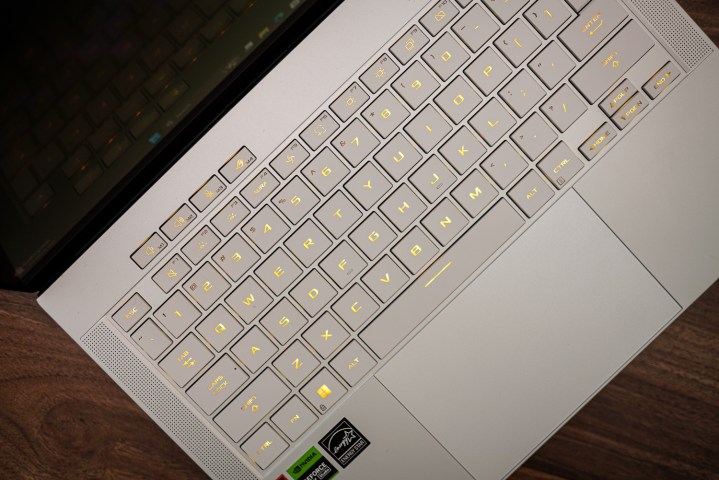
I’m happy that Asus didn’t mess with the keyboard on the 2024 Zephyrus G14. As you can read in my Zephyrus M16 review, this is one of my favorite keyboards on gaming laptops. It’s snappy like you find with the Razer Blade 14, but with just a hair more travel. It’s wonderful to type on, and even after growing accustomed to Razer’s keyboard over the past year, using the Zephyrus G14 felt like going back to an old friend.
You get a large trackpad as well, which now reaches from the bottom of the laptop to the edge of the keyboard. It’s a tad smaller than the trackpad you’ll find on the Blade 14, though still about twice the size of the one you’ll find on the Lenovo Legion 9i.
There isn’t a better laptop screen
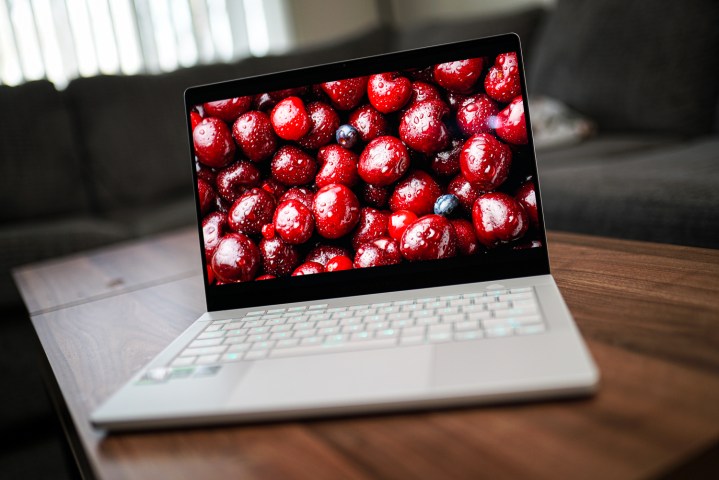
The biggest upgrade the G14 gets this year is the OLED display. We’ve seen OLED before on the Razer Blade 15, but Asus is offering the OLED panel standard on all 2024 G14 models, rather than as an upgrade. All configurations come with the same specs — you get a 16:10 OLED screen with a resolution of 2,880 x 1,800 and a refresh rate of 120Hz.
On top of the impressive specs, the screen supports G-Sync and Adaptive Sync, and it comes with Dolby Vision HDR (despite the fact that Dolby Vision support on Windows is extremely limited). You also get Nvidia Advanced Optimus and an MUX switch, which enables toggling between the dedicated and integrated graphics almost instantly when going in and out of games.
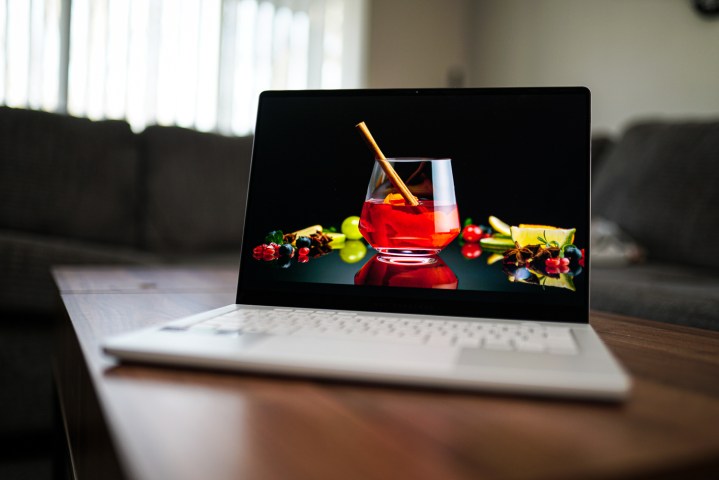
And yeah, it’s just as great as you’d expect. Out of the box, the display posted some of the best color I’ve ever seen out of a laptop. You’re getting 100% coverage of DCI-P3 and sRGB, and a shocking 93% of Adobe RGB. Most impressive is the color accuracy, which showed an error of 0.72 out of the box. That’s wonderful.
Brightness is solid, too, though not quite on the level of a dedicated OLED gaming monitor. In SDR, the screen peaked at about 450 nits, which is great. HDR went up to 670 nits for a 4% window. It’s usable brightness that’s only really outclassed by mini-LED displays we see on laptops like the Asus ROG Strix Scar 18.
A new (old) CPU
The Zephyrus G14 includes AMD’s “new” Ryzen 9 8945HS CPU, which features eight Zen 4 cores, along with a 5.2GHz boost clock speed. The quotation marks are for the fact that this really isn’t a new CPU. It’s a rebranded version of the Ryzen 9 7940HS we saw last year, just with a slightly more powerful AI processor on board.

Performance lands slightly below what you’d find in a larger laptop. You can see that in Cinebench R24’s multi-core test, with the larger HP Omen 16 posting a higher result. The difference isn’t too large, though. A CPU with more power, such as the HX-series part in the Asus ROG Strix G17, shows a massive improvement.

Single-core result are almost identical across the board, now showing that the tiny frame of the Zephyrus G14 doesn’t have a big impact on performance.
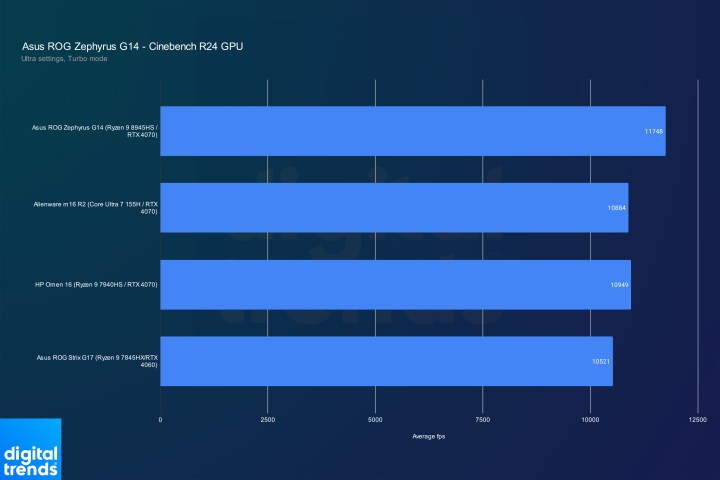
The big question I had was the GPU, given the lower wattage range Asus is sticking with. Even with that lower power, Asus manages to exceed the RTX 4070 in 16-inch designs like the Alienware m16 R2. It’s not a big lead, but even matching the performance of a larger laptop is impressive.
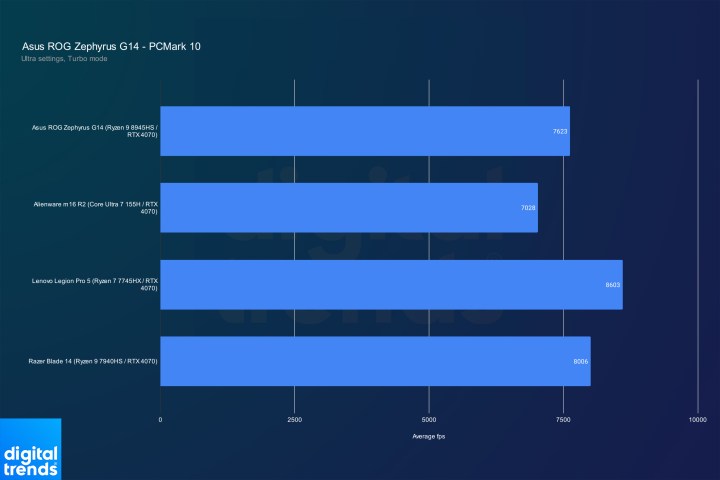
Even with solid performance, the Zephyrus G14 has to contend with the Razer Blade 14, which posts a higher result in PCMark 10 despite using nearly identical hardware. The Blade 14 may be heavier and thicker, but that translates into a performance advantage, at least in some cases.
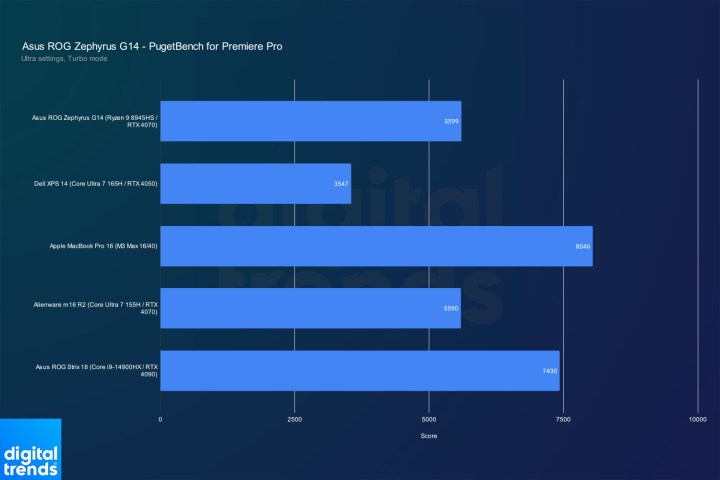
Rounding out productivity performance benchmarks is Premiere Pro, where the Zephyrus G14 is surprisingly component. It can’t hold a candle to an M3 Max, which shouldn’t come as a surprise, but Asus has an advantage over the Alienware m16 R2 despite being much smaller.
Some compromises in gaming
The processor performance for the Zephyrus G14 holds up, but gaming is a much more dense topic. Given the limited TGP of the laptop, I expected the G14 to fall behind the competition. It does, but not by nearly as much as I expected.

The best way to showcase that is with 3DMark. You can see in both Fire Strike (DirectX 11) and Time Spy (DirectX 12) that the Zephyrus G14 is behind laptops packing similar hardware. Asus is behind by about 3%, which doesn’t make a massive difference in real games. In most cases, you’re talking about just a few frames.

As some evidence, you can see a direct comparison between the Zephyrus G14 and Blade 14 above. Asus is a bit behind, as expected, but not by so much that it should greatly impact the experience. The only exception is Cyberpunk 2077, where Asus posted a lower than usual result.
You’re trading a hair of performance for a laptop that is a bit thinner and much lighter, but there’s a little more to the story. For the Blade 14 comparison, I ran games at 1600p on the Zephyrus G14 for a one-to-one comparison. Asus’ laptop has an 1800p display, though. That may not sound like a huge resolution difference, but it has a sizeable impact on performance.

The difference is relatively small in a game like Red Dead Redemption 2, but you’re getting a completely different experience in Cyberpunk 2077, Assassin’s Creed Valhalla, and Horizon Zero Dawn. With the GPU running at a lower power and a higher resolution, the Zephyrus G14 feels slower than it should out of the box. Thankfully, you can still run games at 1600p, and given the power in this laptop, that’s what I’d recommend.
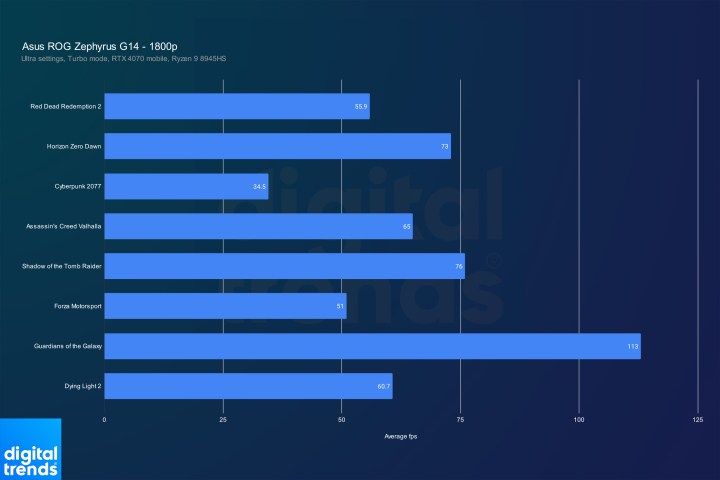
Across a wider swath of games at 1800p, you can see why. There are titles that run without issues like Guardians of the Galaxy, while games like Forza Motorsport, Dying Light 2, and Red Dead Redemption 2 struggle to hold a playable frame rate at native resolution. VRAM issues are also concern at this high of a resolution, particularly in titles like Forza Motorsport that support ray tracing.
This is still a component gaming laptop, but it’s clear that Asus is making some concessions to achieve the MacBook-like form factor of the Zephyrus G14. Performance suffers, particularly at the native resolution of the display, and the laptop gets shockingly hot under full load (though not uncomfortably loud). Pure frame chasers are better off with a larger laptop like the Lenovo Legion Pro 5.
You shouldn’t immediately write the Zephyrus G14 off, though. It trades some performance, yes, but the overall package here can still fit the gaming needs of a lot of players. In practice, the main difference between this laptop and something a bit thicker and heavier is that you’ll need to occasionally turn down some settings or resort to tools like DLSS 3.5 to achieve higher frame rates.
Where Windows hurts
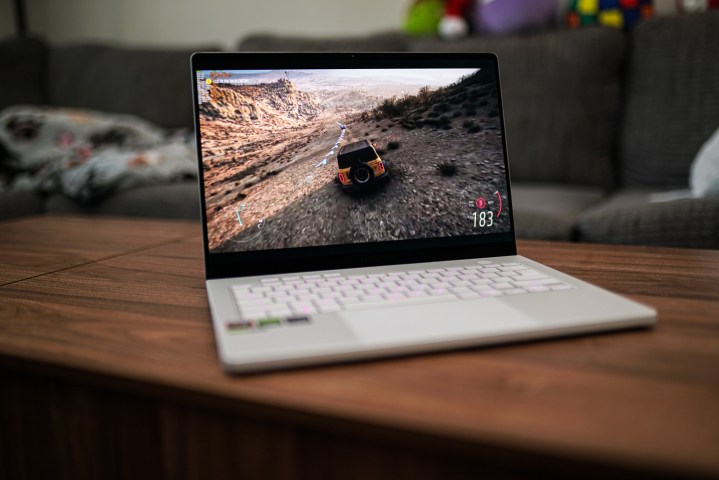
Although the Zephyrus G14 has MacBook-like weight, it sure doesn’t have MacBook-like battery life. In normal use, I was able to get six hours out of the laptop away from a charger, while in our standard web-browsing loop, it fell short of five hours. Even with an MUX switch, the Zephyrus G14 doesn’t have the battery life I would hope for.
A lot of this has to do with expectations. This is a gaming laptop, but it plays the role of a creator laptop so well with its beautiful OLED screen and sleek silver frame. The battery life shows that the hardware under the hood is still built for gaming, and you shouldn’t expect double-digit battery life out of the laptop.
Battery life isn’t terrible, though. The inclusion of USB-C power delivery helps give the laptop some legs for long sessions away from the power brick, and the battery life is long enough that you can get some decent work done before needing a charge.
Should you buy the 2024 Zephyrus G14?
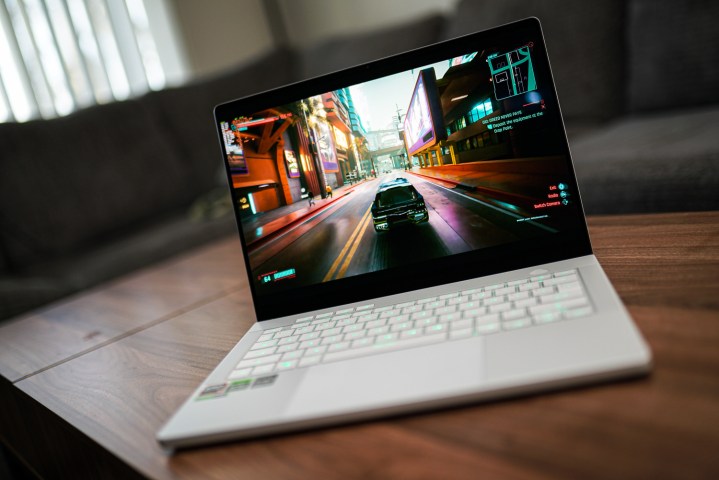
The 2024 Zephyrus G14 has already turned heads and stirred up its fair share of controversy, but it’s still a laptop that excites me. The MacBook-like form factor is unmatched for a gaming notebook, and the OLED display delivers some of the best color quality I’ve ever seen. Even in a sea of 14-inch gaming laptops, I can confidently say that I’ve never used a laptop quite like the 2024 Zephyrus G14. It’s bold in its design, and surprisingly competent in its execution. For the way I use a gaming laptop, there’s nothing better.
It’s important to recognize the many other ways you can use a gaming laptop, though. Peak performance isn’t a priority for the Zephyrus G14, as it relies on a “good enough” mentality to get by. And upgradability is out the door now in an attempt to achieve a design that very few other laptops can match. More than anything, though, the 2024 Zephyrus G14 loses out compared to last year’s model. In an off year for laptop hardware, you can purchase a 2023 model with the same specs for about $400 less. That’s assuming the radical redesign isn’t what you’re after.
For me, I like seeing the Zephyrus G14 start to punch up and take on laptops like the Razer Blade 14 with a superior screen and similar performance for a much lower price. In the context of other 14-inch options floating around the market, the 2024 Zephyrus G14 is a slam dunk.





